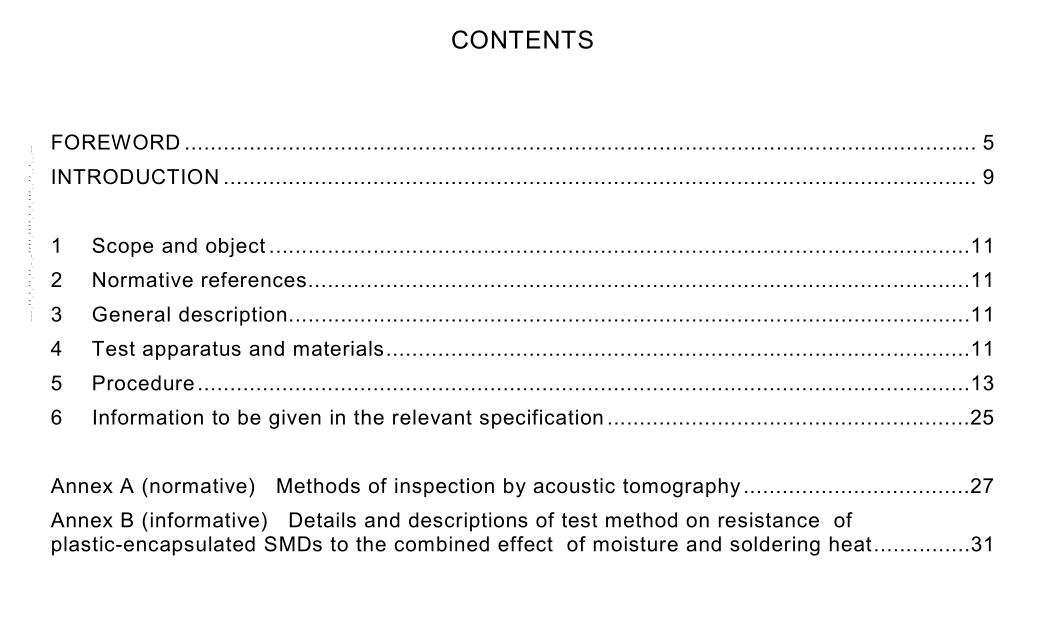IEC 60749-20 pdf download

IEC 60749-20 pdf download.Semiconductor devices – Mechanical and climatic test methods
1 Scope and object
This part of IEC 60749 applies to semiconductor devices (discrete devices and integrated circuits). This test method provides a means of assessing the resistance to soldering heat of plastic- encapsulated surface mount devices (SMDs). This test is destructive. NOTE This test is identical to the test method contained in 2.3 of chapter 2 of IEC 60749 (1996), amendment 2, apart from the addition of this clause and clause 2 and the subsequent renumbering.
2 Normative references
The following referenced documents are indispensable for the application of this document. For dated references, only the edition cited applies. For undated references, the latest edition of the referenced document (including any amendments) applies. IEC 60068-2-20:1979, Environmental testing – Part 2: Tests – Test T: Soldering IEC 60749-3, Semiconductor devices − Mechanical and climatic test methods − Part 3: External visual inspection
3 General description
Package cracking and electrical failure in plastic-encapsulated SMDs can result when soldering heat raises the vapour pressure of moisture which has been absorbed into SMDs during storage. These problems are assessed. In this test method, SMDs are evaluated for heat resistance after being soaked in an environment which simulates moisture being absorbed while under storage in a warehouse or dry pack.
4 Test apparatus and materials
a) Humidity chamber The humidity chamber shall provide an environment complying with the temperature and relative humidity defined in item c) of clause 5. b) Reflow soldering apparatus The infra-red convection, the convection and the vapour-phase reflow soldering apparatus shall provide temperature profiles complying with the conditions of soldering heat defined in items d)1) and d)2) of clause 5. The settings of the reflow soldering apparatus shall be adjusted by temperature profiling of the top surface of the specimen while it is undergoing the soldering heat process, measured as shown in figure 1.c) Holder Unless otherwise detailed in the relevant specification, any board material, such as epoxy fibreglass or polyimide, may be used for the holder. The specimen shall be placed on the holder by the usual means and in a position as shown in figure 1. If the position of the specimen, as shown in figure 1, necessitates changing the shape of terminations and results in subsequent electrical measurement anomalies, a position that avoids changing the shape of terminations may be chosen, and this shall be specified in the relevant specification. d) Wave-soldering apparatus The wave-soldering apparatus shall comply with conditions given in item d)3) of clause 5. Molten solder shall usually be flowed. e) Solvent for vapour-phase reflow soldering Perfluorocarbon (perfluoroisobutylene) shall be used. f) Flux Unless otherwise detailed in the relevant specification, the flux shall consist of 25 % by weight of colophony in 75 % by weight of isopropyl alcohol, both as specified in appendix C of IEC 60068-2-20. g) Solder Solder of composition as specified in appendix B of IEC 60068-2-20 shall be used.
5 Procedure
a) Initial measurements 1) Visual inspection Visual inspection, as specified in IEC 60749-3, shall be performed before the test. Special attention shall be paid to external cracks and swelling, which will be looked for under a magnification of 40×. 2) Electrical measurement Electrical testing shall be performed as required by the relevant specification. 3) Internal inspection by acoustic tomography Unless otherwise detailed in the relevant specification, internal cracks and delamination in the specimen shall be inspected by acoustic tomography in accordance with annex A. b) Drying Unless otherwise detailed in the relevant specification, the specimen shall be baked at 125 °C ± 5 °C for at least 24 h.c) Moisture soak Unless otherwise detailed in the relevant specification, moisture soak conditions shall be selected on the basis of the packing method of the specimen (see B.1.1). If baking the specimen before soldering is detailed in the relevant specification, the specimen shall be baked instead of being subject to moisture soak. 1) Moisture soak for dry-packed SMDs Moisture soak conditions for dry-packed SMDs may be used as specified in method A, table 1, or method B, table 2. Moisture soak conditioning for dry-packed SMDs consists of two stages. The first stage of conditioning is intended to simulate moisturizing SMDs before opening the dry pack/dry cabinet. The second stage of conditioning is to simulate moisturizing SMDs during storage after opening the dry pack for soldering (floor life). Moisture soak conditioning for dry-packed SMDs shall be selected from method A or B. Method A shall be used when the relative humidity in the dry pack or dry cabinet is specified by the manufacturer as being between 10 % and 30 %. Method B shall be used when the relative humidity in the dry pack or dry cabinet is specified by the manufacturer as being below 10 %.









